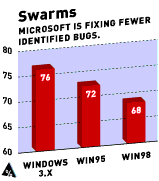Killer
Applications
An
upstart makes a national name for itself
by swatting computer bugs
 ON A SUMMER
AFTERNOON IN 1994, Bruce Brown was
sipping microbrews on a Seattle patio
with a bunch of techies, listening to the
buzz about Win95. It was already late to
launch, and, despite the now-historic
hype, his Microsoft Corp. pals were
calling it "the mother of all
bugs." Brown had an epiphany: He
could turn the growing frustration of
computer users into an opportunity. So in
November, he launched BugNet, a
newsletter on computer bugs and how to
squash them. ON A SUMMER
AFTERNOON IN 1994, Bruce Brown was
sipping microbrews on a Seattle patio
with a bunch of techies, listening to the
buzz about Win95. It was already late to
launch, and, despite the now-historic
hype, his Microsoft Corp. pals were
calling it "the mother of all
bugs." Brown had an epiphany: He
could turn the growing frustration of
computer users into an opportunity. So in
November, he launched BugNet, a
newsletter on computer bugs and how to
squash them.
It was glorious timing. Days after the
debut issue, a major flaw in the Pentium
chip focused national attention on bugs.
Soon, the tiny newsletter had deals with
newspapers and online services such as
the San Jose Mercury News and CompuServe,
putting Brown's snappy tech columns in
front of millions. The broad interest
surprised the experienced journalist and
writer, who had only a hobbyist's
knowledge of computers himself. He had
seen his audience as techies. "We
did not anticipate people sitting on the
toilet reading us," he says.
Since then, bugs have only become more
numerous and good tech help harder to
find. The dreaded Win95 did indeed
overwhelm Microsoft tech support, for
example. "The average American would
never buy an electric razor that was as
buggy and unreliable as a PC," Brown
scoffs. And with Joe Average now getting
wired, bugs concern a wider audience.
BugNet subscriptions, which range from
$65 annually for an individual consumer
to $75,000 for a corporation, continue to
grow. Last year the company created
special rates for small business, to meet
hefty demand.
Robert Johnston, information officer
at the World Bank in Washington, D.C.,
and a computer professional since 1966,
is a typical subscriber. He recently
signed up the bank's IT department after
finding the Web site comprehensive and
helpful. "It warns us of potential
problems," he says. "And the
fact that they lighten it up is
nice."
Clearly, BugNet makes the most of the
Net's freewheeling culture. It doesn't
stint on free content and relies on
word-of-mouth advertising among Web
cognoscenti. Research efforts are
substantially aided by a passionate army
of tech-smart volunteers who love to find
and fix bugs. A handful of staffers toil
at headquarters in Sumas (Wash.), in a
six-bedroom house near the Canadian
border that Brown's grandfather bought in
1917. But most work at home, from as far
away as London. They're managed through
an intranet, which contains editorial
guidelines, deadlines, contact
information, and photos of all the staff.
Revenues come from subscriptions,
syndication, and licensing deals -- all
for the same core product of editorial
content on bugs and fixes. Yearly sales
are still less than $1 million, according
to Brown, but 1998 sales were five
times1995's -- and profits tripled in
1998.
 Actually,
Brown's Company has always been in the
black, if just barely at first. Starting
as a one-man show, Brown trawled online
forums for user complaints, researched
solutions, and wrote the snail-mail
newsletter himself. Marketing to an
upmarket cohort of sophisticated users in
large corporate and government entities,
the company picked up visibility-boosting
subscribers such as Hewlett-Packard Co.
and Bear, Stearns & Co. early on. Actually,
Brown's Company has always been in the
black, if just barely at first. Starting
as a one-man show, Brown trawled online
forums for user complaints, researched
solutions, and wrote the snail-mail
newsletter himself. Marketing to an
upmarket cohort of sophisticated users in
large corporate and government entities,
the company picked up visibility-boosting
subscribers such as Hewlett-Packard Co.
and Bear, Stearns & Co. early on.
Word spread, bringing in newspaper and
online deals. When Brown got a contract
to write a Win95 bug-fix book, he made
his first hire: Bruce Kratofil, a
business consultant based in Cleveland
and a BugNet senior editor. (In five
years of collaboration, Brown has never
met Kratofil face to face. "We're
thinking we're going to have to meet some
day," Kratofil says.)
By late 1995, the company had axed the
mail version and launched www.bugnet.com.
That brought in ad dollars from big
spenders such as Microsoft and Intel
Corp., while eliminating print costs.
More recently, BugNet has licensed its
growing database of bug info to MSNBC,
ZDNet, and IDG's Infoworld.
Each week, BugNet editors wade through
some 500 complaints from stymied users,
described in a recent BugNet editorial as
coming "like sufferers to Lourdes in
an endless river of sorrow." The
roughly 10% of problems that are judged
most serious or widespread are
researched. BugNet first checks whether
the vendor is aware of the problem and
has any patches. Sometimes, the makers
are grateful, since a proliferation of
programs and platforms makes it
impossible to plan for every contingency.
Of course, manufacturers sometimes
balk. In these instances, BugNet calls on
its own tech experts and independent
testing lab partners to provide
solutions. Or it may get help from a
subscriber like Brent Kellogg, a
47-year-old dentist in Everett, Wash.,
who spends a couple of hours a day
"playing" on a network of six
computers in his home. Each month he
looks through the BugNet database of
problems for things he can fix. Now what
would you give for customers like that?
By
Edith Updike
This article was originally published in
the Apr. 26, 1999 print edition of
Business Week's Frontier. To subscribe,
please see our subscription
policy.
CHART:
Swarms
Preventive
Pesticides for Your PC
 To:
TECHNOLOGY
To:
TECHNOLOGY
|

